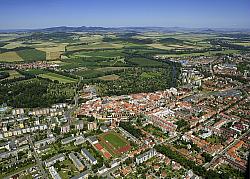Louny – walking trail Ohře
Route length: 1 km
Route description:
- short walk along the river Ohře from the Jirásek Mills to the Puppet theater. On three information panels you can find information
sabout the river Ohře, bank vegetation and ongoing constructionsalong the walking trail. - more details can be found here
River Ohře
The river rises under the mountain Schneeberg (elevation of 754 m) in Bavarian spruce groves. It is the second largest tributary of the river Labe. The river enters the Northwestern Bohemian area in Chomutov district and it flows into the Labe in Litoměřice. Many water reservoirs were built in the basin of the river Ohře, of which the largest are Skalka, Jesenice and Nechranice. The total length of the stream is 300.2 square kilometers. The Czech name “ Ohře“, like the German name “Eger“, is derived from the Celtic name “Agaru“, which supposedly means salmon river. The first written mention of the Ohře river dates from the 9th century AD. There were Slavs in the “ Poohří“ (Ohře area) back then who completely pushed away the original Celtic and partly Germanic inhabitants. In the 1880s the first fishing associations were set up. Their goal was to take care of the fish and the river. Currently, under the program called “Salmon 2000”, removal of barriers to the Ohře’s flow is ongoing. By building fish transitions, the salmon are starting to slowly return.
Birdlife by the river
The river bank is formed by a relatively steep slope oriented to the north, with trees such as willow, lime, elm, oak, ash hawthorn and maple. Under the trees grow bushes like devilwood, hazel, greybeard and cornel. The herb layer is dominated by weeds such as nettles, touch-me-nots, geums etc. On land, hidden under the bushes, certain types of songbirds like blackcap, whitewing, nightingale, etc., are nesting. Frequently the birds build a nest in the middle of bushes or trees. The hollows of the trees are occupied by starlings, great-spotted woodpeckers, etc. In general, 20 kinds of birds nest here. The river Ohře is also an important winter site of waterfowl.
Řopík floods
In order to avoid any damages during floods, the water level has been monitored since 1884. A machine to control the critical flood flow - water level recorder – was installed in 1901. Along the old stairs, right by the walking trail, there is a level gauge with a mark of the city’s worst flood of the 19th century which occured in in 1862. Řopík is the name of a small building along the walking trail. It is a concrete blockhouse of an infantry border fortification.






